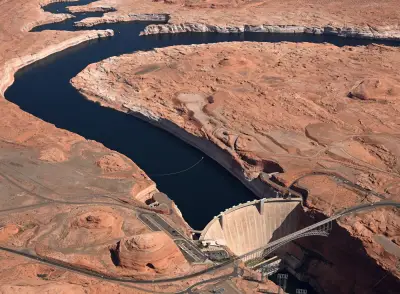Chance of Colorado River deal is ‘tenuous’ just two months before federal deadline, negotiator says

The likelihood of Western states reaching a consensus on a plan for the future of the Colorado River is dimming as time runs out for the negotiators tasked with dividing up the shrinking river relied upon by million people The path to success seems tenuous at this point Arizona s negotiator Tom Buschatzke mentioned in an interview this week with The Denver Post The discussions continue to revolve around the main issue that we ve been struggling with for selected time since these discussions started Colorado and the six other states in the Colorado River basin for more than a year have failed to agree on how to share the river s water after current management plans expire at the end of Little progress has been made on the central question How should the states divide up the cuts required as the river is shrunk by drought and environment change We re pretty far apart and we haven t made a lot of progress closing the gap Buschatzke explained The states have until Nov to tell the federal authorities whether they will have a deal and until Feb to submit a detailed plan If consensus cannot be reached the U S Bureau of Reclamation will implement its own plan a scenario that would likely prompt years of expensive litigation and put complicated water management questions in the hands of judges who aren t specialized in the issues Litigation would create massive uncertainty in the basin and product in a decision that is not ideal for anyone experts and state negotiators have explained Buschatzke s candid comments are rare for negotiators involved in the closed-door discussions though tensions have occasionally flared into the population eye Colorado s negotiator Becky Mitchell revealed in a message this week in response to Buschatzke s comments that time is of the essence in the negotiations The states have no option but to live within the means of the river she disclosed We re grappling with complex laborious trade-offs but we re all at the table Mitchell stated Too much is at stake for positioning and posturing in the media and ignoring the fact that Lake Powell and Lake Mead are in big trouble The Colorado River is the lifeblood of southwestern U S cities irrigates more than million acres of farmland provides critical wildlife habitat and fuels recreation economies worth millions of dollars The river supplies large portions of a multitude of Western cities water portfolio Half of Denver s water comes from the Colorado River system as does of Las Vegas water The Upper Basin states Colorado Wyoming New Mexico and Utah sit upstream of Lake Powell and Lake Mead Without large reservoirs in which to store water those states water supply is reliant on snowpack and precipitation which can vary widely year to year In contrast the water supply for the Lower Basin states California Arizona and Nevada is more consistent and predictable as it comes from Lake Mead and Lake Powell A cow walks across barren land on August south of Kingman Arizona Photo by RJ Sangosti The Denver Post Who should take cuts Both basins say they have already borne the brunt of the cuts that both sides agree are necessary Negotiators from the Lower Basin for months have argued that their counterparts in the Upper Basin must agree to mandatory usage cuts in the driest years The Lower Basin has already made notable cuts to address the shrinking river Buschatzke revealed this week Arizona has reduced its water usage by acre-feet in and acre-feet in Buschatzke noted Much of those cuts were required by the Drought Contingency Plan and a multitude of water users were paid for using less water he announced An acre-foot of water would cover a football field in a foot of water and is generally enough for two to four families annual use The Upper Basin states maintain that they already take water cuts every year because they are above the system s two major reservoirs Since they re reliant on snowpack and precipitation they re forced to live within the supply of the river Unlike the Lower Basin states the Upper Basin has never used its entire legal allotment while the Lower Basin for years used more water than the river supplied and depleted water supplies stored in Mead and Powell the basin s negotiators have commented In Colorado when there is not enough water to fulfill water rights the state engineer s office cuts users supplies This summer drought and low river flows prompted water-use restrictions across much of the Western Slope On average Colorado water users take acre feet of cuts every year because of a lack of water Mitchell stated Water users are not paid for those cuts We have the tools to solve this we just need the leadership and resolve to implement them Mitchell revealed in her announcement In Colorado we use the prior appropriation doctrine to live within our means It is harsh It means that water users take uncompensated mandatory reductions Water flows are low in a section of the Colorado River where the Shoshone Generating Station a hydroelectric power plant diverts water to generate power before returning it downstream east of Glenwood Springs on Sept Photo by RJ Sangosti The Denver Post Split is about as wide as Grand Canyon Negotiators continue to discuss a concept that would base the amount circulated from the system s two major reservoirs on the amount of water flowing in the river rather than the decades-old system that bases releases on water levels at Lake Powell and Lake Mead The negotiators spoke publicly last month about the concept which particular hailed as a feasible breakthrough in negotiations But optimism around that concept has faded Mitchell mentioned it was unclear whether an agreement could be reached around the framework Buschatzke commented major sticking points remained like what percentage of the flow each basin should receive Related Articles A conceptual breakthrough has emerged for the Colorado River s future Here s what it looks like Western Colorado is at the epicenter of drought as a hot dry summer saps water supplies and fuels wildfires The Colorado River is in trouble Certain groups want the authorities to step up Colorado River states still have no unified long-term management plan and are just about out of time experts warn We certainly have not come to an agreement on what that split should be Buschatzke stated The gap between what we think should be the number and what the Upper Basin thinks the number should be is about as wide as the Grand Canyon He declined to share each basin s proposed percentages The basins have agreed on how to calculate the natural flow which is the amount of water that would be in the river without any human intervention That number will serve as the base from which the percentages are derived The states are not discussing a stopgap agreement that could hold off federal decisionmaking Buschatzke explained The states continue to meet regularly he reported Meanwhile Lake Mead and Lake Powell sat less than a third full as of Thursday The Bureau of Reclamation earlier this month circulated projections that presented that if drought continues Lake Powell s water levels could drop so low by November that water will not be able to flow through the dam s hydroelectric turbines The worst-case scenario projections show Powell could drop to about full and Mead to full by July As the basin prepares for the transition to post- operating guidelines the urgency for the seven Colorado River Basin states to reach a consensus agreement has never been clearer explained Scott Cameron the acting assistant secretary for water and science at the U S Department of the Interior in an Aug news release about the projections We cannot afford to delay Get more Colorado news by signing up for our Mile High Roundup email newsletter

